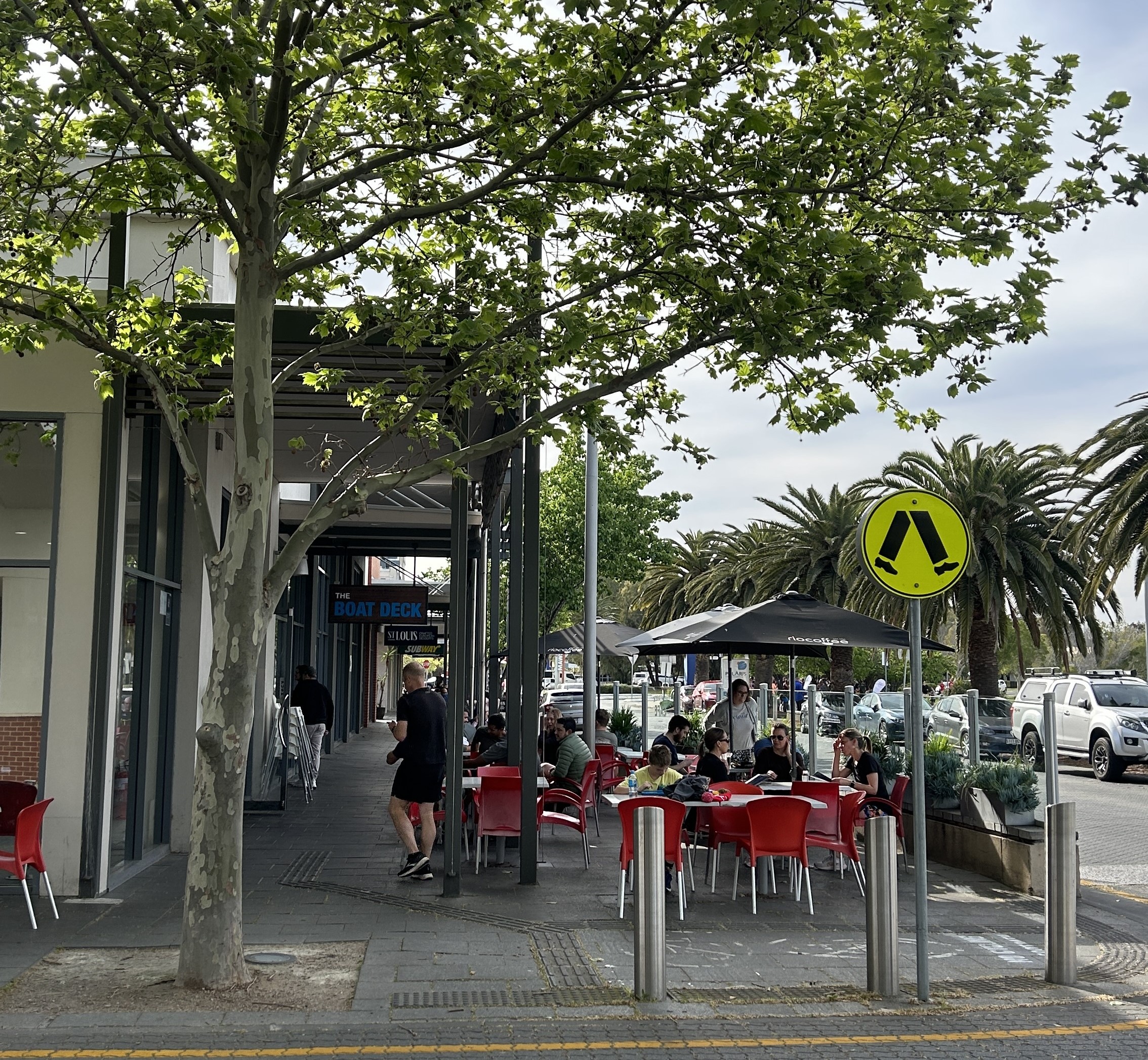On the Greater Adelaide Regional Plan
The Greater Adelaide Regional Plan (GARP) could be South Australia’s most important urban plan. The 2010 version — the 30 Year Plan — and its 2017 update were influential in setting the planning direction for the region, including a strong emphasis on urban consolidation, housing diversity and sustainable living.
“… need to transition to an urban environment centred on walkable neighbourhoods and access to public transport.”
A new regional plan has recently been proposed by the South Australia Government’s State Planning Commission. Planning is often about balancing — as best as you can — differing objectives and interests, and I thought I would share some balanced observations on the draft GARP with five things I like and five things I don’t.
Five things I like about the Greater Adelaide Regional Plan…
1. Regenerative planning and liveability championed
Right from the start this document champions Adelaide as “one of the most liveable cities in the world”. This focus continues with a planning approach to “living locally” to foster vibrant communities where (for example) walking and cycling are viable options to live healthy and meaningful lives.
I agree that making existing and new neighbourhoods for local living is a great goal to have. And I would agree that Adelaide is a liveable city, with abundant natural and community assets. It’s easy to get around and less expensive to live in than the bigger capitals — one of the reasons many people (including me) come to live here.
Several other progressive themes are mentioned in the plan, all of which deserve credit:
- Planning with Country to incorporate Aboriginal cultural values and priorities into planning.
- Regenerative planning moving beyond sustainability to restore and repair landscapes and communities – a big theme for me and my colleagues.
- Circular thinking for economies and communities.
- “A greener, wilder and more climate resilient environment” sounds pretty good too.
- Many other good regional and local planning principles are included, comprehensive and well thought out — there’s something for everyone!
2. Housing diversity in all locations and developments is an important move.
Housing is a big priority right now. And housing usually is the focus of Australian metropolitan plans, simply because housing takes up the most urban land. There’s always development pressure for housing. It always needs to be dealt with.
As with the earlier regional plans, promoting more diversity of housing, including in greenfield residential areas, is a good policy. Proposed measures for minimum housing density and diversity in greenfield areas, and expanding the affordable housing overlay, could help.
The ‘missing middle’ idea promoting attached housing and apartment designs that are low in scale and good to live in — like quadplexes, shop-top housing, terrace housing etc — is not a new idea. But we need to keep trying hard to achieve it.
3. Housing targets for local government areas are a good thing.
“More housing in the right places” is stated outcome number one.
Having targets should motivate planners and leaders at local government level — although they’ll work best if local governments get the chance to plan how to achieve these targets for themselves.
Targets should also help inform local communities about future changes in their area. Targets will also help us all monitor progress.
The City of Adelaide’s plan to double population to 50,000 by 2041 is a good example of a plan and a target at local government level.
4. Online presentation.
The digital version of the draft plan is being heavily promoted and it is a useful way of browsing the polices proposed, alongside the spatial dimensions of the plan via the online mapping. I do have some reservations about making strategic plans cadastrally based — in many cases the detailed planning to determine boundaries of growth areas or infill areas has not been worked out — but people do seem to respond better to property-based information so I suppose it’s just the way it goes!
5. Detailed action plan is a positive.
Plans without a commitment to implementation are less valuable. This regional plan has a detailed action plan with 37 actions or implementation projects proposed. It’ll need substantial resourcing over many years, and many of the proposals are just tinkering with the Planning & Design Code, but it’s a good start.
And five things I dislike… (there’s always going to be some of these too)
1. A greenfield-heavy growth future will be expensive and less liveable.
The plan identifies new land for another 100,000 homes in previously undeveloped or greenfield land, some inside the Environment and Food Production Area (EFPA), set up not long ago to protect food growing regions from exactly this. (It also identifies at least the same amount of homes in strategic infill locations and half that again in local infill areas.)
The Government’s own Housing Roadmap and infrastructure plan shows how expensive and difficult it is to provide basic services to greenfield areas outside the city. Why plan for the same difficulties again?
The plan is right to question the quality and local impacts of general infill development — the small lot subdivisions and townhouses that are often cheaply designed, result in neighbourhood tree loss, and fill suburban streets with parked cars.
But general infill has delivered large amounts of relatively affordable housing close to shops and buses and parks and other services. In other words, close to where people want to live.
Interestingly, the South Australian switch from an infill focus to greenfield is being done at the same time as larger states like New South Wales and Victoria are doing the opposite.
2. Unrealistic growth agenda?
The plan assumes an additional 670,000 people onto the 1.5 million already here. That’s more than 22,000 extra each year, every year, for 30 years.
The 1.2% average annual growth rate in recent years is relatively high for Adelaide (but not in the Australian context). Does one year of bumper growth in overseas migration, fuelled by international students (most of whom probably live in the city of Adelaide) point to a long-term regional trend? Probably not.
Moving to adopt a “high-growth scenario” when medium growth is the usual long-term tracker for regional plans could be said to be planning ahead — or might be raising expectations.
3. The public will be waiting a long time for the public transport to arrive.
The plan is scant on details when it comes to the public transport investments that would be needed to support a liveable future for the extensive urban expansion the GARP proposes — the so-called “integrated and connected region”. There are hints about rail extensions in the north and south, but that’s all they are.
The Department for Infrastructure and Transport is said to be developing a transport strategy for release in 2025. Transport was hardly mentioned in the 2023 discussion paper so it is good to see that strategies for a connected region have been added.
4. GARP continues the state’s takeover of urban planning in South Australia.
The plan identifies numerous “State significant” infill areas including major road corridors and town centre locations — the State Government says they will lead planning for these areas. Same for employment precincts.
Regional centres like Elizabeth, Port Adelaide and Modbury will also be planned by the state — but is more planning really needed? Councils have done the planning already, over and over again. Perhaps the missing ingredient is state investment in projects to catalyse private investment?
And of the 37 actions, all but one is to be delivered by state departments or agencies — does this equate to collaboration with other governments, or with business or the community sector?
5. Big on growth areas but short on vision of how to make these liveable or sustainable.
Kudla/Hillier is long contested planning space. Is it an urban break or “green belt” separating the Town of Gawler from rapidly growing Playford to the south? Is it a place for local horticultural production or rural living on the floodplains of the Gawler River, close to markets and communities? Or is it an opportunity for suburban development for the 400+ landowners spread across this area, many on small landholdings?
We are not neutral observers, having recently prepared the Gawler Growth Framework that plans for about 5,000 new dwellings while retaining a green belt between Gawler, Playford and the Gawler River.
The GARP has other ideas and has proposed more than double this number of houses 13,400 (30,000 people? Bigger than Town of Gawler today) and a “Northern Parklands” on publicly owned Renewal SA land on its northern edge. The parklands will be a great resource for locals, but given the land ownership the development of this area will be hard work and may lead to fragmented outcomes.
Huge growth is also planned at Roseworthy (33,300 dwellings, 70-80,000 people!), north-west of Gawler and already accommodating new residential developments. Does this exposed country, away from rivers and beaches and town centre services, provide the regional liveability that makes Adelaide one of the most liveable cities in the world? I don’t think so.
I was recently at Mawson Lakes where a mixed-use medium density town centre with high amenity was developed as part of a government-developer joint venture only 20 years ago. It’s a high-quality example and there are others.
The draft regional plan is arguably short on the vision and methods for how we can create similar neighbourhoods or town centres for the future. I recommend this gets more attention in the final plan.
What are your thoughts on the GARP? Join the conversation on my LinkedIn blog post.
Michael McKeown
Director

